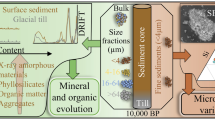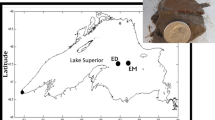Abstract
Easily discernible sediment varves (annual laminations) may be formed in temperate zone lakes, and reflect seasonal changes in the composition of the accumulating material derived from the lake and its catchment (minerogenic and organic material). The appearance of varves may also be influenced by chemical processes. We assessed the role of iron (Fe) and sulfur (S) in the appearance of varves in sediments from Lake Nylandssjön in northern Sweden. We surveyed Fe in the lake water and established whether there is internal transport of Fe within the sediment. We used a unique collection of seven stored freeze cores of varved sediment from the lake, collected from 1979 to 2004. This suite of cores made it possible to follow long-term changes in Fe and S in the sediment caused by processes that occur in the lake bottom when the sediment is ageing. We compared Fe and S concentrations using X-ray fluorescence spectroscopy (XRF) in specific years in the different cores. No diagenetic front was found in the sediment and the data do not suggest that there is substantial vertical transport of Fe and S in the sediment. We also modeled Fe and S based on thermodynamic, limnological, and sediment data from the lake. The model was limited to the five components H+, e−, Fe3+, SO4 2−, H2CO3 and included the formation of solid phases such as Fe(OH)3 (amorphous), FeOOH (aged, microcrystalline), FeS and FeCO3. Modeling showed that there are pe (redox) ranges within which either FeS or Fe(OH)3/FeOOH is the only solid phase present and there are pe ranges within which the two solid phases co-exist, which supports the hypothesis that blackish and grey-brownish layers that occur in the varves were formed at the time of deposition. This creates new possibilities for deciphering high-temporal-resolution environmental information from varves.








Similar content being viewed by others
References
Bindler R, Wik-Persson M, Renberg I (2008) Landscape-scale patterns of sediment sulfur accumulation in Swedish lakes. J Paleolimnol 39:61–70. doi:10.1007/s10933-007-9095-0
Bodek I, Lyman W, Reehl W, Rosenblatt DH (1988) Environmental inorganic chemistry. Pergamon Press, New York
Bostick BC, Theissen KM, Dunbar RB, Vairavamurthy MA (2005) Record of redox status in laminated sediments from Lake Titicaca: a sulfur K-edge X-ray absorption near edge structure (XANES) study. Chem Geol 219:163–174. doi:10.1016/j.chemgeo.2005.02.004
Carignan R, Flett RJ (1981) Postdepositional mobility of phosphorus in lake sediments. Limnol Oceanogr 26:361–366
Cheburkin AK, Shotyk W (1996) An Energy-dispersive Miniprobe Multielement Analyzer (EMMA) for direct analysis of Pb and other trace elements in peats. Fresenius J Anal Chem 354:688–691
Cheburkin AK, Shotyk W (2005) Energy-dispersive XRF spectrometer for Ti determination (TITAN). Xray Spectrom 34:69–72. doi:10.1002/xrs.766
Davison W (1993) Iron and manganese in lakes. Earth Sci Rev 34:119–163. doi:10.1016/0012-8252(93)90029-7
Davison W, De Vitre R (1992) Iron particles in freshwater. In: Buffle J, van Leeuwen HP (eds) Environmental particles, vol 1. Lewis, Boca Raton
Engstrom DR, Wright HE (1984) Chemical stratigraphy of lake sediments. In: Haworth EY, Lund JWG (eds) Lake sediments and environmental history. Leicester University Press, Bath, pp 11–67
Eriksson G (1979) An Algorithm for the computation of aqueous multicomponent, multiphase equilibriums. Anal Chim Acta 112:375–383. doi:10.1016/S0003-2670(01)85035-2
Gälman V, Petterson G, Renberg I (2006) A comparison of sediment varves (1950–2003 AD) in two adjacent lakes in northern Sweden. J Paleolimnol 35:837–853. doi:10.1007/s10933-005-5952-x
Gälman V, Rydberg J, Sjöstedt de-Luna S, Bindler R, Renberg I (2008) Carbon and nitrogen loss rates during aging of lake sediment: changes over 27 years studied in varved lake sediment. Limnol Oceanogr 53:1076–1082
Gunnars A, Blomqvist S, Johansson P, Andersson C (2002) Formation of Fe(III) oxyhydroxide colloids in freshwater and brackish seawater, with incorporation of phosphate and calcium. Geochim Cosmochim Acta 66:745–758. doi:10.1016/S0016-7037(01)00818-3
Holmer M, Storkholm P (2001) Sulphate reduction and sulphur cycling in lake sediments: a review. Freshw Biol 46:431–451. doi:10.1046/j.1365-2427.2001.00687.x
Karlsson M, Lindgren J (2006) http://www.dagger.mine.nu/MAJO/winsgw.htm
Kemp ALW, Thomas RL, Dell CI, Jaquet J-M (1976) Cultural impact on geochemistry of sediments in Lake Erie. J Fish Res Bd Can 33:440–462
Koinig KA, Shotyk W, Lotter AF, Ohlendorf C, Sturm M (2003) 9000 years of geochemical evolution of lithogenic major and trace elements in the sediment of an alpine lake—the role of climate, vegetation, and land-use history. J Paleolimnol 30:307–320. doi:10.1023/A:1026080712312
Lidén J (1983) A study of equilibrium reactions of Fe2+ during its diffusional transport through the anoxic hypolimnion of an ice-covered lake. Schweiz Z Hydrol 45:411–429. doi:10.1007/BF02538132
Nipkow F (1920) Vorläufige Mitteilungen über Untersuchungen des Schlammabsatzes in Zürichsee. Zeutschrift Hydrologie 1:100–122. doi:10.1007/BF02485147
Odegaard C, Rea DK, Moore TC (2003) Stratigraphy of the mid-Holocene black bands in Lakes Michigan and Huron: evidence for possible basin-wide anoxia. J Paleolimnol 29:221–234. doi:10.1023/A:1023239908588
Ojala AEK, Saarinen T, Salonen V-P (2000) Preconditions for the formation of annually laminated lake sediments in southern and central Finland. Boreal Environ Res 5:243–255
O’Sullivan PE (1983) Annually-laminated lake sediments and the study of Quaternary environmental changes—a review. Quat Sci Rev 1:245–313. doi:10.1016/0277-3791(83)90008-2
Pankow JP (1991) Aquatic chemistry concepts. Lewis Publ Inc, Chelsea
Petterson G (1996) Varved sediments in Sweden: a brief review. In: Kemp AES (ed) Palaeoclimatology and palaeoceanography from laminated sediments, vol 116. Geological Society Special Publications, London, pp 73–77
Petterson G, Renberg I, Geladi P, Lindberg A, Lindgren F (1993) Spatial uniformity of sediment accumulation in varved lake sediments in northern Sweden. J Paleolimnol 9:195–208. doi:10.1007/BF00677213
Renberg I (1976) Annually laminated sediments in Lake Rudetjärn, Medelpad province, northern Sweden. Geol Foren Stockh Forh 98:355–360
Renberg I (1981) Improved methods for sampling, photographing and varve-counting of varved lake sediments. Boreas 10:255–258
Renberg I (1982) Varved lake sediments—geochronological records of the Holocene. Geol Foren Stockh Forh 104:275–279
Renberg I (1986) Photographic demonstration of the annual nature of a varve type common in N. Swedish lake sediments. Hydrobiologia 140:93–95. doi:10.1007/BF00006731
Rydberg J, Gälman V, Renberg I, Bindler R, Lambertsson L, Martinez-Cortizas A (2008) Assessing the stability of mercury and methylmercury in a varved lake sediment deposit. Environ Sci Technol 42:4391–4396. doi:10.1021/es7031955
Saarnisto M (1986) Annually laminated lake sediments. In: Berglund BE (ed) Handbook of Holocene palaeoecology and palaeohydrology. Wiley, New York, pp 343–370
Sasseville DR, Norton SA (1975) Present and historic geochemical relationships in four Maine lakes. Limnol Oceanogr 20:699–714
Shchukarev A, Gälman V, Rydberg J, Sjöberg S, Renberg I (2008) Speciation of iron and sulphur in seasonal layers of varved lake sediment: an XPS study. Surf Interface Anal 40:354–357. doi:10.1002/sia.2704
Urban NR (1994) Retention of sulfur in lake sediments. In: Baker LA (ed) Environmental chemistry of lakes and reservoirs. Am Chem Soc, Washington, DC, pp 323–369
Urban NR, Ernst K, Bernasconi S (1999) Addition of sulfur to organic matter during early diagenesis of lake sediments. Geochim Cosmochim Acta 63:837–853. doi:10.1016/S0016-7037(98)00306-8
Wetzel RG (2001) Limnology, 3rd edn. Academic Press, San Diego
Acknowledgements
We thank all those who provided help during field work throughout the years, and two anonymous reviewers for constructive comments that markedly improved the paper. This work was supported by the Swedish Research Council and the Faculty of Science and Technology, Umeå University. The XRF measurements were performed at the RIAIDT of the University of Santiago de Compostela by Manuela Costa Casais.
Author information
Authors and Affiliations
Corresponding author
Rights and permissions
About this article
Cite this article
Gälman, V., Rydberg, J., Shchukarev, A. et al. The role of iron and sulfur in the visual appearance of lake sediment varves. J Paleolimnol 42, 141–153 (2009). https://doi.org/10.1007/s10933-008-9267-6
Received:
Accepted:
Published:
Issue Date:
DOI: https://doi.org/10.1007/s10933-008-9267-6




